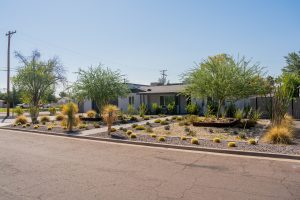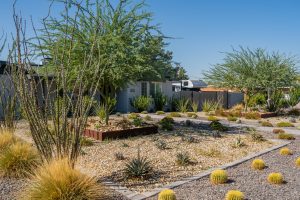- Slug: BC-CNS Xeriscaping Incentives, 570 words.
- 2 photos and captions below.
- 1 video here.
By Sydney Witte
Cronkite News
MESA – Kelly Gleave converted his grass lawn to xeriscape in April. In June, he and his wife saw a 3,000 gallon reduction in their water use.
“For me, it was less about maintaining the grass and it was more about the fact that the Valley is getting a lot of people and we need to do more to conserve water,” said Gleave, who’s one of 450 Mesa homeowners who have taken advantage of the city’s grass-to-xeriscape incentive.
The U.S. Bureau of Reclamation announced in August that deliveries of Colorado River water – the majority of which is used for agriculture – to Arizona would be cut an additional 21% next year.
According to the bureau, megadrought and low runoff conditions accelerated by climate change have resulted in record low water levels in Lakes Powell and Mead, the two largest reservoirs in the country.
Because of the cuts to Arizona’s water and the state’s climate conditions, homeowners should consider sustainable ways to use water, according to Warren Tenney, the executive director of the Arizona Municipal Water Users Association, an organization of 10 Valley cities whose website says protects its members’ water supplies “by ensuring laws and regulations support water resources sustainability enabling continued prosperity in the desert.”
Tenney said watering lawns efficiently is an important way municipal customers can conserve. More than half of residential household water goes toward landscaping, he said, and in some cases, it’s as much as three quarters.
Xeriscaping can help. The artistic approach to landscaping includes the use of drought-tolerant plants and efficient irrigation. Xeriscape has become a popular style of landscaping across the Valley for many years – even Phoenix Sky Harbor International Airport swapped its green lawns for xeriscape in 2019.
Mesa offers up to $500 for homeowners who replace grass with xeriscape to save water and money. Qualifying homeowners must remove at least 500 square feet of grass and replace it with succulents, cactuses, aloe, shrubs and trees that thrive in desert heat and can survive on rainfall or a low-use watering system.
The Mesa Grass-to-Xeriscape and Trees Are Cool programs – homeowners who plant low-water-use trees can qualify for an additional $50 or $75 – can help homeowners reduce their landscape water use by half or more.
Homeowners are making the change for two reasons.
“A lot of the people that do this program in particular tell me they want to do it because, number one, they want to save water, and number two, they want less maintenance,” said Becky Zusy, the conservation coordinator for Mesa.
Zusy said 1,000 square feet of xeriscape uses about 15,000 gallons of water annually, while 1,000 square feet of overseeded grass uses about 35,000 gallons annually.
Chandler also has a water conservation rebate and incentive program offering up to $200 for installation of xeriscape at a newly constructed home or up to $3,000 for a grass lawn conversion.
Tenney said most landscape plants don’t need as much water as many homeowners think, and that when watering grass, “really let the ground soak and then don’t worry about watering quite so long.”
Tenney said the water shortage in the Colorado River Basin is serious and expected to get worse. More needs to be done to make a bigger reduction in Arizona’s water use, he said, and that will depend on agriculture.
According to the Arizona Department of Water Resources, irrigated agriculture is Arizona’s largest water consumer, using about 74% of the available water supply.
For more stories from Cronkite News, visit cronkitenews.azpbs.org.
^__=

